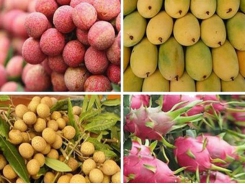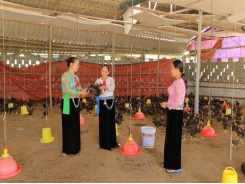Vietnamese fruits step into choosy markets

Recently, many Vietnamese fruits have been licensed to export to the most "choosy"markets in the world, such as the US, Japan and Australia. This is a positive signal, promising the possibility of sustainable export of fruits in the future, avoiding dependence on the Chinese market.
Currently, the amount of fruit exported to "choosy" marketsaccounts for more than 30%. Photo: Nguyen Thanh
5 years into Japan, 10 years into the US
The latest report by the Bureau of Agricultural Product Processing and Market Development (Ministry of Agriculture and Rural Development) showed that the export value of fruits and vegetables in 2019 was estimated at US$3.74 billion, down 1.9% compared to 2018. China ranked first in Vietnam's vegetable and fruitexportswith over 65% market share.Fruit and vegetable exports dropped mainly due to the declinein demandfrom the Chinese market.In the first 11 months of 2019, fruit and vegetable exports to China reached US$2.24 billion, down 13.2% compared to the same period in 2018.However, it is worth noting that in most other markets,Vietnamese fruit and vegetable exports experienced growth. Specifically, exports to the US reached US$137.7 million, up 9.2%; South Korea reached US$119.4 million, up 14.2%; Japan reached US$112.4 million, up 14.4%.
Mr. Nguyen Quoc Toan, Head of the Bureau of Agricultural Product Processing and Market Development, said that the decrease in vegetable and fruit exportsin2019 was a result that must be accepted, because China had tightened quotas and only imported official goods. Many advantageous fruits and vegetables of Vietnam had not been granted official export permits to China, so they boosted domestic consumption or increased processing.
2019 was not an easy year for exporting Vietnamese vegetables and fruits. However, despite the difficulties, there were still bright spots asVietnamese fruits penetrated a series of "choosy" markets. In mid-December 2019, Japan's Ministry of Agriculture, Forestry and Fisheries (MAFF) sent a letter to the Plant Protection Bureau (Ministry of Agriculture and Rural Development) officially announced the acceptanceof Vietnamese lychee.Accordingly, Vietnam’s lychee was officially allowed to be exported directly to Japan with the regulations on Japanese quarantine of imported plants.This regulation came into force from December 15, 2019.This is the result of more than five years of negotiationsbetween the Plant Protection Bureau and MAFF, while many rigorous experiments were conducted to ensure thorough eradication ofJapanese plant quarantine which were capable of infesting Vietnamese lychee.
In August 2019, after long negotiations, the Australian Ministry of Agriculture and Water Resources allowed fresh Vietnamese longan to be exported officially to this country. Longan is the fourth fruit allowed to be exported to Australia after passing many quality control standards. At the same time, Chile also allowed Vietnamese mangoes to be exported to Chile. In February 2019, Vietnamese mangoes were also allowed to be exported to the US after 10years of negotiations,after lychee, longan, rambutan, star apple and dragon fruit.The US has become the 40th export market of Vietnamese mangoes.
Improve quality, increase production
Mr. Le Son Ha, Head of Plant Quarantine Division(Plant Protection Bureau) saidthat markets such as the US and Australia only required irradiationwhen exporting lychee, while Japan required steam disinfection treatment.It took Vietnam more than two years to conductsteam disinfection experimentsto thoroughly eradicate plant quarantine objects that might infest lychee. In the end, the Japanese expert came to check it directly and approved.“This is a new breakthrough, the first time we have done steam disinfection treatmentand have been accepted by the Japanese market.This success is not only for lychee, but also a precondition for other fruits to be exported to Japan, and even Korea, because these two countries only acceptsteam disinfection treatment, not irradiation,”Mr. Ha said.
According to Mr. Ha, the potential export fruits of Vietnamhave so far penetrated most of the most “choosy” markets in the world.Currently, the amount of fruit exported to "choosy" marketsaccount for more than 30%, including very good growth markets such as the US, South Korea, Australia and Canada. However, currently,competitors with Vietnam such as Cambodiahave been exporting mangoes to Korea, while China has expanded dragon fruit growing area.
“If the Vietnamese fruit industry does not change, it will be difficult. In addition to quality, ensuring food hygiene and safety requires farmers to produce goods on a large scale to meet the large orders of importers. This is still a problem for Vietnam's fruit industry,” Mr. Ha said.
Mr. Nguyen Quoc Toan said this was still a very important market for Vietnamese fruits and must strive to meet market requirements. Vietnamese goods were exported to China, mainlyin the provinces of Nanning, Guangxi. Goods also were under other brand names.This was a concern.This needs to change in the way that ministries and branches accompany enterprises, the Chinese Embassy in Vietnam and VietnameseEmbassy in China to connect enterprisesto the Chinese distribution chain, not to exchange through intermediary middlemen, but trade directly. Thus, the value of the seller is guaranteed, the new export value chain has achieved high results.
“One of the factors that increase the competitiveness of Vietnamese fruits in particular and Vietnamese agricultural products in general in exporting is to reduce logistics costs. To do so, the solution is to establish logistics infrastructure in border areas, with cold storages to store, preserve and extend the expiration time.Regarding processing, packaging, enterprises should also pay more attention which is requirement for all enterprises regardless ofscale," Mr. Toan said.
Related news
Tools

Phối trộn thức ăn chăn nuôi

Pha dung dịch thủy canh

Định mức cho tôm ăn

Phối trộn phân bón NPK

Xác định tỷ lệ tôm sống

Chuyển đổi đơn vị phân bón

Xác định công suất sục khí

Chuyển đổi đơn vị tôm

Tính diện tích nhà kính

Tính thể tích ao



 Binh Thuan opens tours to dragon fruit fields
Binh Thuan opens tours to dragon fruit fields  Cooperative develops Huong Nhuong hill chicken brand
Cooperative develops Huong Nhuong hill chicken brand